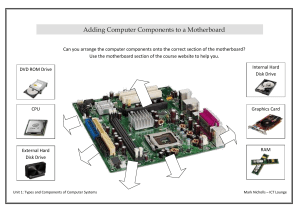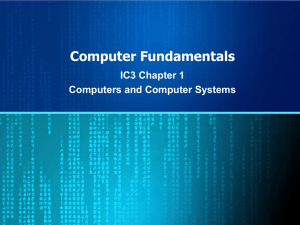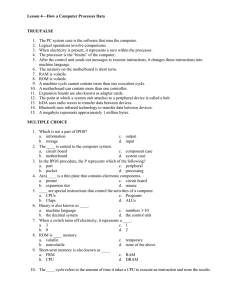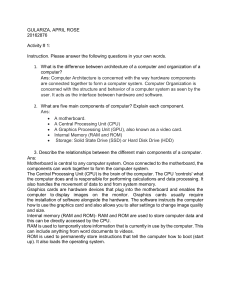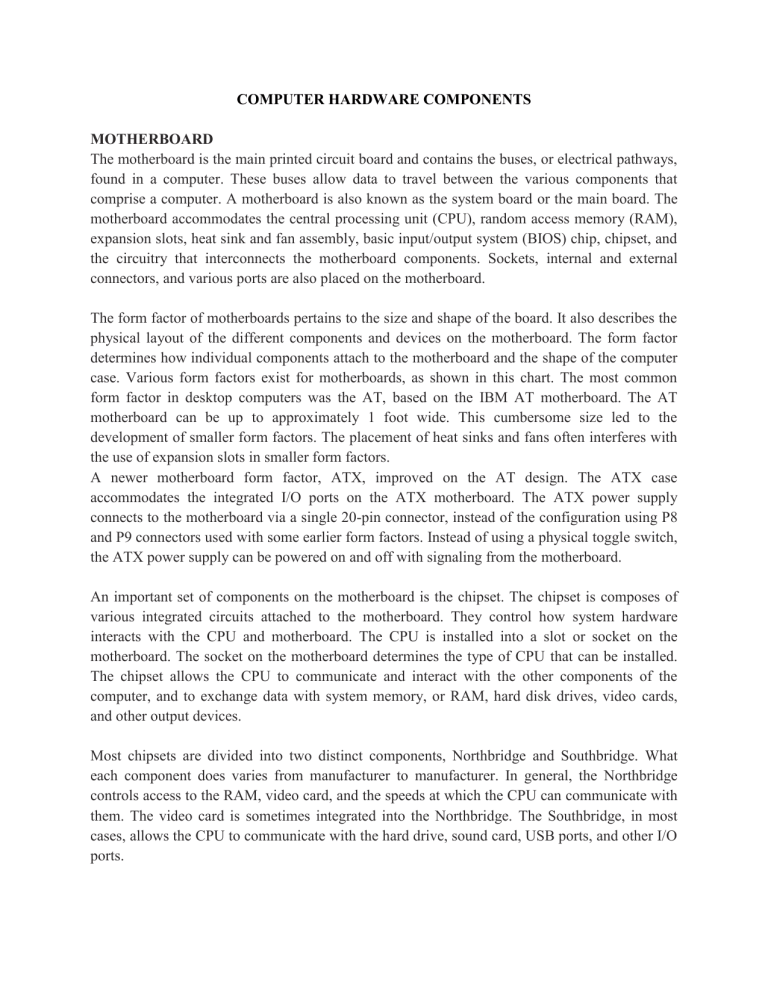
COMPUTER HARDWARE COMPONENTS MOTHERBOARD The motherboard is the main printed circuit board and contains the buses, or electrical pathways, found in a computer. These buses allow data to travel between the various components that comprise a computer. A motherboard is also known as the system board or the main board. The motherboard accommodates the central processing unit (CPU), random access memory (RAM), expansion slots, heat sink and fan assembly, basic input/output system (BIOS) chip, chipset, and the circuitry that interconnects the motherboard components. Sockets, internal and external connectors, and various ports are also placed on the motherboard. The form factor of motherboards pertains to the size and shape of the board. It also describes the physical layout of the different components and devices on the motherboard. The form factor determines how individual components attach to the motherboard and the shape of the computer case. Various form factors exist for motherboards, as shown in this chart. The most common form factor in desktop computers was the AT, based on the IBM AT motherboard. The AT motherboard can be up to approximately 1 foot wide. This cumbersome size led to the development of smaller form factors. The placement of heat sinks and fans often interferes with the use of expansion slots in smaller form factors. A newer motherboard form factor, ATX, improved on the AT design. The ATX case accommodates the integrated I/O ports on the ATX motherboard. The ATX power supply connects to the motherboard via a single 20-pin connector, instead of the configuration using P8 and P9 connectors used with some earlier form factors. Instead of using a physical toggle switch, the ATX power supply can be powered on and off with signaling from the motherboard. An important set of components on the motherboard is the chipset. The chipset is composes of various integrated circuits attached to the motherboard. They control how system hardware interacts with the CPU and motherboard. The CPU is installed into a slot or socket on the motherboard. The socket on the motherboard determines the type of CPU that can be installed. The chipset allows the CPU to communicate and interact with the other components of the computer, and to exchange data with system memory, or RAM, hard disk drives, video cards, and other output devices. Most chipsets are divided into two distinct components, Northbridge and Southbridge. What each component does varies from manufacturer to manufacturer. In general, the Northbridge controls access to the RAM, video card, and the speeds at which the CPU can communicate with them. The video card is sometimes integrated into the Northbridge. The Southbridge, in most cases, allows the CPU to communicate with the hard drive, sound card, USB ports, and other I/O ports. Computer Motherboard CPU The central processing unit (CPU) is considered the brain of the computer. It is sometimes referred to as the processor. Most calculations take place in the CPU. In terms of computing power, the CPU is the most important element of a computer system. CPUs come in different form factors, each style requiring a particular slot or socket on the motherboard. Common CPU manufacturers include Intel and AMD. The CPU socket or slot is the connection between the motherboard and the processor. Most CPU sockets and processors in use today are built around the architectures of the pin grid array (PGA), and land grid array (LGA). In PGA architecture, pins on the underside of the processor are inserted into the socket, usually with zero insertion force (ZIF). ZIF refers to the amount of force needed to install a CPU into the motherboard socket or slot. In LGA architecture, the pins are in the socket instead of on the processor. Slot based processors are cartridge-shaped and fit into a slot that looks similar to an expansion slot. The CPU executes a program, which is a sequence of stored instructions. Each model of processor has an instruction set, which it executes. The CPU executes the program by processing each piece of data as directed by the program and the instruction set. While the CPU is executing one step of the program, the remaining instructions and the data are stored nearby in a special memory called cache. Two major CPU architectures are related to instruction sets: • Reduced Instruction Set Computer (RISC) - Architectures use a relatively small set of instructions. RISC chips are designed to execute these instructions very rapidly. • Complex Instruction Set Computer (CISC) - Architectures use a broad set of instructions, resulting in fewer steps per operation. The latest processor technology has resulted in CPU manufacturers finding ways to incorporate more than one CPU core onto a single chip. These CPUs are capable of processing multiple instructions concurrently: • Single Core CPU - One core inside a single CPU that handles all the processing. A motherboard manufacturer might provide sockets for more than one single processor, providing the ability to build a powerful, multiprocessor computer. • Dual Core CPU - Two cores inside a single CPU in which both cores can process information at the same time. • Triple Core CPU - Three cores inside a single CPU that is actually a quad-core processor with one of the cores disabled. • Quad Core CPU - Four cores inside a single CPU • Hexa-Core CPU - Six cores inside a single CPU • Octa-Core CPU - Eight cores inside a single CPU COOLING SYSTEMS The flow of current between the electronic components generates heat. Computer components perform better when kept cool. If the heat is not removed, the computer may run slower. If too much heat builds up, computer components can be damaged. Increasing the air flow in the computer case allows more heat to be removed. A case fan installed in the computer case to makes the cooling process more efficient. In addition to a case fan, a heat sink draws heat away from the CPU core. A fan on top of the heat sink, as shown in Figure below, moves the heat away from the CPU. Other components are also susceptible to heat damage and are sometimes equipped with fans. Video adapter cards also produce a lot of heat. Fans are dedicated to cool the graphics-processing unit (GPU), as shown in Figure below. Computers with extremely fast CPUs and GPUs might use a water-cooling system. A metal plate is placed over the processor, and water is pumped over the top to collect the heat that the processor generates. The water is pumped to a radiator to release the heat into the air and is then re-circulated. ROM Memory chips store data in the form of bytes. Bytes represent information such as letters, numbers, and symbols. A byte is a grouping of digital information in computing. A byte is most commonly a block of eight bits. Each bit is stored as either 0 or 1 in the memory chip. Read-only memory (ROM) chips are located on the motherboard and other circuit boards. ROM chips contain instructions that can be directly accessed by a CPU. Basic instructions for operation, such as booting the computer and loading the operating system, are stored in ROM. ROM chips retain their contents even when the computer is powered down. The contents cannot be erased or changed by normal means. ROM: Read-only memory chips. Information is written to a ROM chip when it is manufactured. A ROM chip cannot be erased or re-written and is obsolete. PROM: Programmable read-only memory. Information is written to a PROM chip after it is manufactured. A PROM chip cannot be erased or re-written. EPROM: Erasable programmable read-only memory. Information is written to an EPROM chip after it is manufactured. An EPROM chip can be erased with exposure to UV light. Special equipment is required. EEPROM: Electrically erasable programmable read-only memory. Information is written to an EEPROM chip after it is manufactured. EEPROM chips are also called Flash ROMs. An EEPROM chip can be erased and re-written without having to remove the chip from the computer. NOTE: ROM is sometimes called firmware. This is misleading, because firmware is actually the software that is stored in a ROM chip. RAM RAM is the temporary storage for data and programs that are being accessed by the CPU. RAM is volatile memory, which means that the contents are erased when the computer is powered off. The more RAM in a computer, the more capacity the computer has to hold and process large programs and files. More RAM also enhances system performance. The maximum amount of RAM that can be installed is limited by the motherboard. DRAM: Dynamic RAM is a memory chip that is used as main memory. DRAM must be constantly refreshed with pulses of electricity in order to maintain the data stored within the chip. SRAM: Static RAM is a memory chip that is used as cache memory. SRAM is much faster than DRAM and does not have to be refreshed as often. SRAM is much more expensive than DRAM. FPM MEMORY: Fast Page Mode DRAM is memory that supports paging. Paging enables faster access to the data than regular DRAM. FPM memory was used in Intel 486 and Pentium systems. EDO MEMORY: Extended Data Out RAM is memory that overlaps consecutive data accesses. This speeds up the access time to retrieve data from memory, because the CPU does not have to wait for one data access cycle to end before another data access cycle begins. SDRAM: Synchronous DRAM is DRAM that operates in synchronization with the memory bus. The memory bus is the data path between the CPU and the main memory. Control signals are used to coordinate the exchange of data between SDRAM and the CPU. DDR SDRAM: Double Data Rate SDRAM is memory that transfers data twice as fast as SDRAM. DDR SDRAM increases performance by transferring data twice per clock cycle. DDR2 SDRAM: Double Data Rate 2 SDRAM is a faster than DDR-SDRAM memory. DDR2 SDRAM improves performance over DDR SDRAM by decreasing noise and crosstalk between the signal wires. DDR3 SDRAM: Double Data Rate 3 SDRAM expands memory bandwidth by doubling the clock rate of DDR2 SDRAM. DDR3 SDRAM consumes less power and generates less heat than DDR2 SDRAM. RDRAM: RAMBus DRAM is a memory chip that was developed to communicate at very high rates of speed. RDRAM chips are not commonly used.

